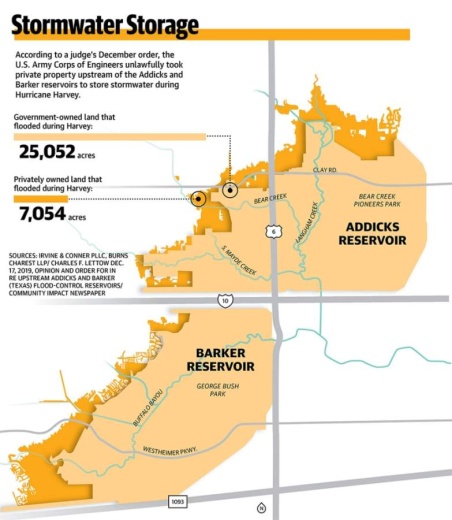After a hearing April 28, Senior Judge Charles Lettow of the U.S. Court of Federal Claims issued an opinion and order April 30 concluding that the Corps took the upstream private property to store stormwater on Aug. 30, 2017, not the 1940s when the reservoirs' construction completed, as argued by the government.
This date is important because it will help determine how much compensation property owners may be eligible for due to the taking of the property, according to the opinion and a press release from the team of lawyers representing the property owners. A trial on the damages is on schedule for a fall date, per the release.
“[The Aug. 30, 2017, date] means the value of the property will be measured from the time of Harvey, not decades before as the Government requested,” the release states.
The Department of Justice said in a February email that it declines comment because the lawsuit is in active litigation.
The April 30 opinion and order also limited the flowage easement to the elevation of the flood pool during Harvey, according to the release. This means that if the Harvey flood pool is ever exceeded due to how the Corps operates the reservoirs, a new lawsuit can be filed for additional compensation, the release states.
In this litigation, a permanent flowage easement refers to the land the Corps used to store inundated water from Hurricane Harvey on private property without compensation, and it refers to the government's right to use the property again, said Mary Conner, who is part of the team of lawyers representing the property owners, in an April email interview. The word "permanent" indicates the Corps will flood the private properties again if the entity does not make any changes to its operations.
The opinion also clarified that damages from the taking will include both real and personal property, the release pointed out.
"[T]he court notes that the taking also encompassed—as a consequential result of the flowage easement taken—plaintiffs’ personal property, fixtures, and improvements damaged or destroyed by the flood event that climaxed on August 30, 2017," the opinion states.
In December, Lettow issued an opinion and order concluding the Corps was liable for flooding the upstream property during Hurricane Harvey, but it did not specify when exactly when the Corps took the property to store impounded floodwaters.
“The court’s opinion addressing liability did not expressly identify the date when the taking of the flowage easement occurred, as it was unnecessary to do so to reach a determination on liability,” Lettow wrote in the April 28 opinion. “That date is significant, however, for assessing the measure of just compensation due.”
Receiving compensation—which could range from $1 billion-$5 billion divvied out among the thousands of property owners who join the class-action lawsuit—will not come immediately for property owners, the team representing the property owners said at the January town hall meeting. After Lettow issues an opinion and order about the damages, the government will likely appeal the judge’s decisions.
To receive compensation, however, property owners upstream of the reservoirs must join the lawsuit. They have until August 2023 to sign up. More information is available here.
Lawsuit timeline
- Aug. 25, 2017: Hurricane Harvey makes landfall; U.S. Army Corps of Engineers closes Addicks and Barker reservoirs' gates
- Aug. 28, 2017: Corps begins releasing impounded stormwater from the reservoirs
- Sept. 5, 2017: first lawsuit of hundreds filed by property owners relating to Harvey and the reservoirs
- November-December 2017: chief judge creates two dockets for upstream and downstream properties lawsuits
- Spring 2018: 13 test cases selected for the upstream lawsuit
- May 6, 2019: 10-day trial for upstream cases held in Houston, which included the judge visiting the reservoirs and test properties, to determine whether the Corps was liable
- Sept. 13, 2019: court hears closing arguments on upstream case in Washington, D.C.
- Dec. 17, 2019: judge issues opinion and order in favor of property owners, concluding the Corps was liable for taking private property
- January 2020: preparation for the upstream damages trial begins to determine just compensation
- Feb. 18, 2020: downstream lawsuit dismissed in its entirety
- April 28, 2020: virtual hearing held to determine date of the taking and scope of the taking
- April 30, 2020: judge issues opinion and order concluding the taking occurred Aug. 30, 2017, and the taking includes the Harvey flood pool
- Fall 2020: trial on damages





